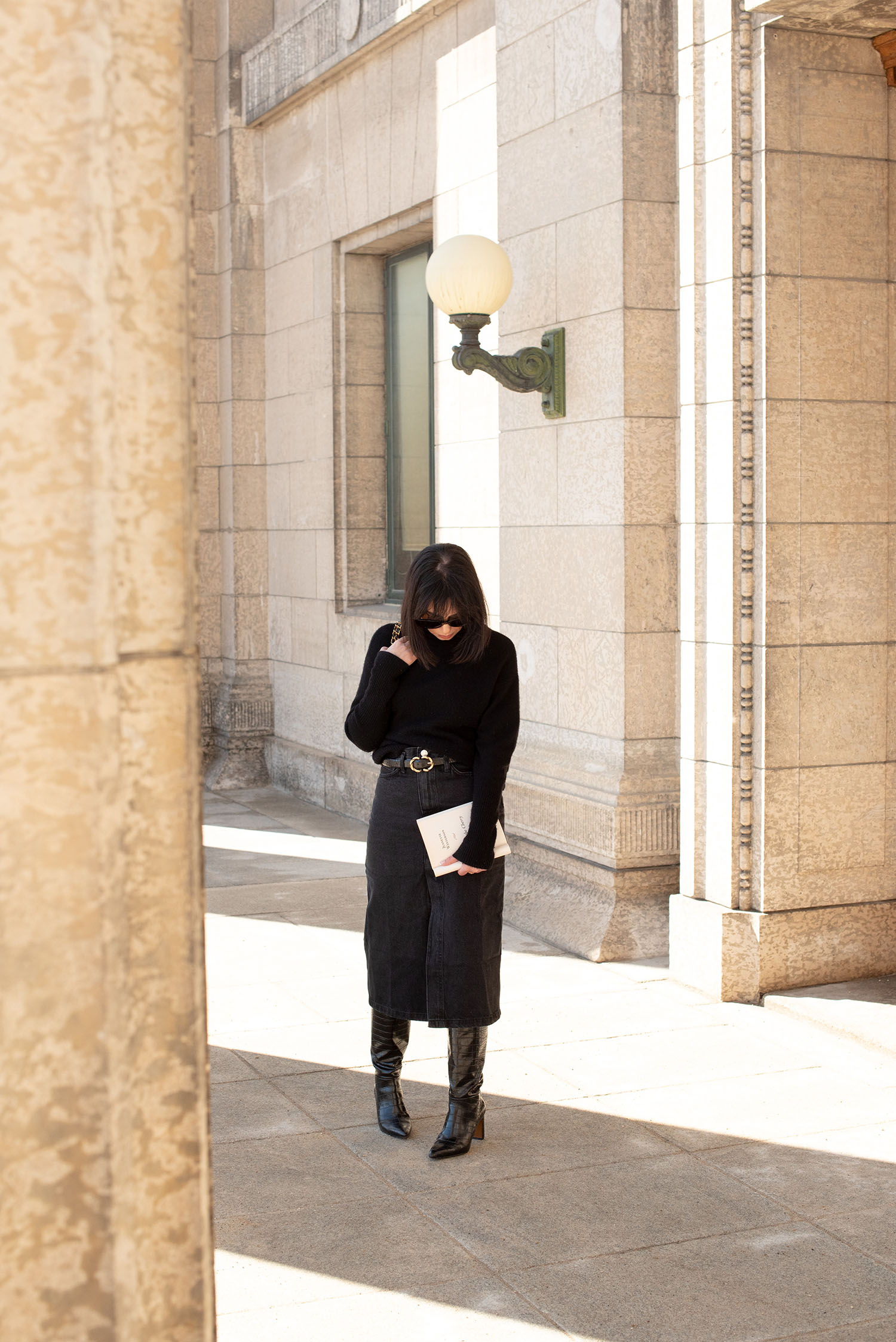
Mango skirt
Mango boots
Chanel handbag
Mango belt
Celine sunglasses
Linjer rings (c/o) (similar)
Modu Atelier earrings (c/o) (similar)
Location: The Manitoba Legislature – Winnipeg, Manitoba
Book: Sexing the Cherry – Jeanette Winterson
I fell in love with our most recent Athenian apartment for so many reasons. But first, the moment we opened the front door, because of the bookshelves. When we walked in, there they were, on the righthand side of it – two of them, stacked almost floor to ceiling, with books in English, French and Greek. I read eight of them during our stay. Two were by Jeanette Winterson. If there had been more of her books on the shelves, that number would have been greater.
Winterson published her first novel the year I was born. Sexing the Cherry came four years later, in 1989. Somehow, though, her masterful literary works flew under my radar until last fall. I’ve been making up for lost time since, collecting every one of her books that I can get my hands on.
I thought it was Winterson’s autobiographical works, particularly the hilarious but heartbreaking Why Be Normal When you Can Be Happy? that I loved best. That was until I picked up Sexing the Cherry. The book jacket summary describes the novel as being set during the right of Charles II, which at once true and untrue. The truth is that this novel defies conventional description. It is set during the reign of Charles II but also in the present, also in a world that does not exist but that, reading about it, we find ourselves hoping could exist.
That’s the thing about this book that makes it so unlike any other you might pick up, the thing that sets Winterson’s prose apart from the work of her peers. Reading Sexing the Cherry is a bit like walking through a wax museum. Everything looks real, feels real, but in a vivid, heightened way that you know means it cannot be – and yet it’s so striking, so lovely that you can’t help but hope it might be, somewhere. Nothing in the novel is quite real, quite true to life, although it all comes just close enough that it might be mistake for reality – except the emotions.
Winterson renders her characters, in particular the historical ones, characters who are typically not afforded full humanity in fiction (because writing about history is really more about rendering the place and time than the people in it,) with unusual, sometimes devastating sensitivity. The Dog Woman in particular, a social misfit and unlikely mother, expresses the internalised shame that so many women, if not all women, feel for the crime of being born less than physically perfect. But the shame she carries, while a burden, never holds her down or back. A feminist before the invention of the word, she makes her way through the world with the conviction that she has a right to do so, not always right but often not wrong. And along the way, she experiences wonders, and creates her own, raising Jordan, the son she did not expect.
Jordan, brought up by a woman who is not his biological mother, an unconventional woman in a conformist era, devotes his life to seeking adventure. And he, too, experiences wonders – including the discovery of the first pineapple. But what is looking for, he discovers along the way, is not adventure at all, but rather a sense of himself and his place in the world. In that way, he is like all of us. And the Dog Woman is, too. Both characters exist in a time that is unknown to us and, we can tell as we read, not quite true to history. But they feel and experience life just as we do.
It is their feelings and experiences, which are so true to life, so accurately articulated by Winterson, that make them easy to love – if we are prone to it. Sexing the Cherry reminds me, every time I pick it up, that we see things not as they are but as we are. That means it doesn’t really matter if the worlds within it are real. We can only see them through the lens of our own perspective, anyway. In that way, nothing is quite real but as we perceive it. And while feelings are not facts, in many contexts, nothing is quite real but emotion.
Jeanette Winterson is such a beautiful writer. I read Written on the Body for one of my literature classes at university and I thought it was the most gorgeous book I’d ever read. I proceeded the devour everything else she’d written. I wish I could discover her again.